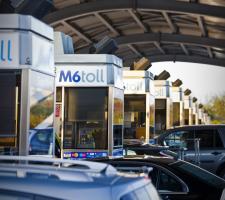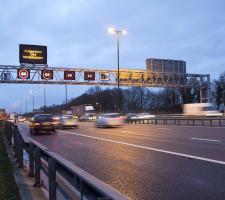
It’s one minute to midnight for funding England’s roads, according to a timely new report - and the clock’s big hand is pointing to some form of user-pay solution, reports David Arminas.
Is there any way out of future user-pay funding for England’s highway infrastructure? The answer is a resounding ‘no’, according to the recently-published report Funding Roads for the Future. The 25-page document by the London-based Association for Consultancy and Engineering (
It says that, unless the private sector is brought into play as a direct investor and operator of highways, England’s roads will be starved of money for essential maintenance and expansion. A more sustainable and - in the eyes of the report’s authors - more equitable funding mechanism is required sooner rather than later.
It should be noted that the report covers the highway network in England only. Responsibility for roads in Scotland, Wales and Northern Ireland has been devolved to the respective national legislatures. The UK government in London is responsible for funding roads in England, which is the focus of the ACE’s report.
Toll-free roads
With the exception of bridges, England is a nation of toll-free roads, barring one short - 43km - six-lane motorway. The privately-owned M6 Toll around the city of Birmingham opened in 2002.
The UK government estimates traffic on England’s roads could increase by up to 55% by 2040. Many European countries are grappling with similar problems of increasing congestion, air pollution, adequate maintenance funding and how to adapt to new driving technologies such as electric and autonomous vehicles as well as truck platooning.
“From an infrastructure advisory position, we are approaching a critical point, a tipping point, where we cannot rely on the public purse to fund ongoing maintenance,” Dave Beddell, managing director of strategic highways Europe at global US engineering firm
Beddell, who is also chairman of ACE’s road sector interest group which produced the report, continues: “There has to be a private finance solution. The challenge that both government and industry has is to make that investment an attractive proposition for potential investors.”
Not sexy
The issues are perhaps felt most acutely in England, where the population density is among the highest in the world. This is less so in the other nations of the UK: Scotland, Wales and Northern Ireland. But local roads anywhere aren’t a sexy subject, explains Beddell: “Local roads have suffered from decades of neglect and we are now beginning to see the result of this on what is a mature infrastructure. We applaud the funding going into the main national strategic road network, but it is only part of the users’ journey. We need to take a holistic view of what investment is needed.”
The ACE report believes current financing problems will only get worse unless addressed now. The UK government has already taken steps to ensure proper maintenance of England’s trunk roads – motorways and A-class highways. It launched the Road Investment Strategy (RIS 1) in late 2014 and in April 2015 created the standalone, government-owned company
Highways contractors applauded the strategy and five-year financial commitment. Previously it was a year-to-year commitment which meant businesses suffered great uncertainty about what contracts, if any, were coming down the pipe. Also, the
But the money still has to come from somewhere. Funding for local roads is particularly precarious, according to the report. While these roads represent 98% of the network by kilometres and carry two-thirds of traffic, the tight budgets of local authorities mean local roads often miss out on investment. Also, the UK government acknowledges that congestion will be a major issue, likely to increase 63% by 2030. At the same time, revenue from taxes related to roads is drying up.
Continued decline
Generally, the growing number of low- and zero-emission vehicles means revenue from the national vehicle excise duty (VED) and fuel duty will continue to decline. VED is a tax on the ownership of a vehicle based on CO2 emissions. A car with no CO2 emissions has no VED costs, whereas a car emitting over 255 grams of CO2/km costs $2,800 (£2,000) in the first year and nearly $200 (£140) in following years.
While revenue from VED is expected to rise slightly over the next five years from around $8.5 billion (£6 billion) in 2017-18 to nearly $9.7 billion (£6.8 billion) in 2022-23, the current structure of VED and the inevitable uptake of zero-emission vehicles will see revenue from VED decline.
The government’s ban on the sale of new petrol and diesel vehicles from 2040 and industry expectations of a switch-over to electric vehicles by the mid-2020s means VED will dwindle further.
The report, instead, urges VED be phased in for zero-emission vehicles over the next decade as it increasingly competes with petrol and diesel vehicles on price. This option should ensure that VED revenue grows at, or above, inflation beyond 2040 when the sale of new petrol and diesel vehicles are banned.
London's congestion charge and T-charge
Introduced in 2003, the London congestion Charge is reportedly one of the largest such zones in the world, but a plan to extend it westward has been dropped. In 2013 the ultra-low emission discount (ULED) introduced tougher emission standards that limit free access to the congestion charge zone to all-electric cars, some plugin hybrids and any vehicle that emits 75g/km or less of CO2 and meets the Euro 5 standards for air quality. A toxicity charge - also known as the T-charge - was introduced last
October. Older and more polluting cars and vans that do not meet Euro 4 standards have to pay extra on top of the congestion charge to drive in central London. The charge typically applies to diesel and petrol vehicles registered before 2006.
Road user levy
Consider the government’s move to the road user levy for HGVs: it was frozen at just over £10 ($14) per day or £1,000 ($1,415) a year and had raised around £46.5 million ($66 million) from foreign-registered HGVs by 2015. But UK-registered owners of HGVs can offset their levy with what they spend on VED, which whittles down the money for roads.
The UK government should charge foreign registered HGVs a higher road user levy or reduce the VED costs for UK-registered HGVs. And there would be no offsetting against VED for UK HGV owners.
However, the report points to the need for some form of ‘dynamic road user charging’ for HGVs which will also act as a pilot for a general road-user charge.
For HGVs, technologies such as improved vehicle tracking, can help introduce a dynamic charging levy based on per-distance costs. This could vary based on the vehicle’s location, time of day, congestion on the network, CO2 emissions and the size of the vehicle.
“Using the HGV road user levy as a pilot for the introduction of broader dynamic road user charging across the road network allows the government to address any teething issues prior to a full rollout,” notes the report. However, the report goes on: “The real challenge will be replacing fuel duty with a viable and long-term revenue source.” The government must prepare for a post-fuel duty world now, and the clear answer is the introduction of dynamic road user charging.”
Private investment
The ACE report recommends that the government conducts a study on increasing private investment in the road network and how it is done in other countries. With high upfront costs during the design and construction phase, private investments can make these projects possible and avoid a significant upfront cost to the public.
Consideration should be given to different types of public-private partnerships to unlock this spending by the private companies. However, the government “needs to create more confidence for private investors by ensuring it minimises risks and other uncertainties in road infrastructure projects”, the report concludes.
To be fair, the report also suggests that the government consider new performance metrics to tackle congestion and increase the efficient use of roads. If more private participation is forthcoming, these key performance indicators would likely fall on the shoulders of contractors operating the highways. Metrics may include time lost per vehicle per kilometre, reliability of journey, average speed of vehicles. While may now be monitored, there are no KPI goals attached to the results.
The report does acknowledge that the concept of dynamic road user pricing “has received a mixed response from the public”, predominately because people fear being priced off the road. “The government would benefit from starting a public conversation about the merits of dynamic road user pricing and how this could work.”
Acceptance by the English public of dynamic road pricing would hinge on “user perception of customer amenity”, according to the report. In other words, value for money.
“It’s a myriad of issues,” explains Beddell. “The concept of paying-to-use is prevalent in many walks of life. What we need is a cultural shift when thinking of the road network, similar to people’s perception of using the rail network. Is the train on time? Do I get a seat? Does the refreshments trolley come through the coach? Understanding the customers perception of value they place on the road network and how they measure amenity is the key.”
Spectacular failures
A major hurdle is managing the public’s suspicion of the private sector delivering public services – a suspicion fuelled in the past 20 years with some spectacular failures, most recently that of international contractorIn truth, that conversation about dynamic road pricing started a long time ago. Witness the introduction of the Road Investment Strategy, the formation of Highways England and the Community Infrastructure Levy (CIL). What needs to be done now is to move the conversation from just that – talk – into action. However, as Beddell says, a critical point is nigh if England is not to fall inexorably behind in highway maintenance.
This critical point would be reached at a time of economic uncertainty because of Brexit – the UK is to leave the European Union in 2019. Never has England, and the UK as a whole, needed greater certainty for highways funding. No barrier to lorry charging
The UK’s
The technology needed already exists, with Germany having a successful truck tolling scheme since 2005. Options for technology range from automatic number plate recognition or toll tags to a solution based on an onboard tolling unit or the use of a GPS-enabled dongle plugged into the vehicle’s on-board diagnostic port. “When I was transport minister in the 1990s it was easy for road user charging to be kicked into the long grass because the infrastructure costs were prohibitive,” said Steven Norris, ITS UK president. “There is now no such excuse and any decision is purely a political one.”
Road Investment Strategy 2015-2020
Around £15.2 billion ($21.5 billion) is to be invested in over 100 major schemes. This includes 84 totally new schemes, of which 69 will enter construction by 2020-21. Around £3.5 billion ($5 billion) will be for 20 new schemes to improve some of the most notorious road sections. Another £3.7 billion ($5.2 billion) will be for 64 new schemes to improve safety, ease congestion and for local economies. An additional £900 million ($1.27 billion) will be ring-fenced funds for key local challenges such the environment and air quality as well as cycling safety and integration into road schemes.













